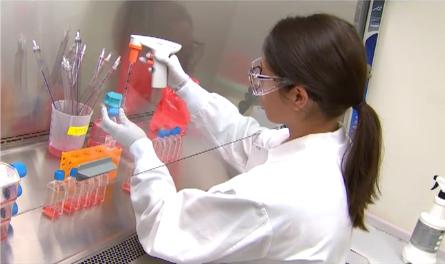Most Medicare enrollees could get insulin for $35 a month
Lower insulin costs could save medicare recipients hundreds of dollars
WASHINGTON — Most Medicare recipients will have access to prescription plans next year that limit their copays for insulin to no more than $35 a month, potentially saving hundreds of dollars, the Trump administration announced Tuesday.
The new benefit — to be formally unveiled at a Rose Garden event Tuesday afternoon — is being touted as a major accomplishment by Trump administration officials eager to change the subject from the grim drumbeat of coronavirus pandemic news.
THE COST OF INSULIN CAN BE DEADLY
Older adults who pick a drug plan offering the new insulin benefit would save an estimated $446 a year, while gaining the ability to budget out-of-pocket costs at a manageable amount. Cost-sharing amounts for prescription drugs can now fluctuate considerably month by month.
The new insulin benefit will be voluntary, so during open enrollment this fall Medicare recipients who are interested must make sure to pick a plan that provides it.
WHO pauses coronavirus hydroxychloroquine trial over safety concerns
Stable copays for insulin are the result of a deal shepherded by the administration between insulin manufacturers and major insurers, Medicare chief Seema Verma told The Associated Press.
“It was a delicate negotiation,” said Verma. Drugmakers and insurers have been at odds in recent years, blaming one another for high prices. “I do think this is a big step.”
Aflac CEO assures policyholders' coronavirus hospital stays will be covered
The deal comes as President Donald Trump returns to the issue of drug prices as he tries to woo older people whose votes are critical to his reelection prospects in November.
The cost of insulin is one the biggest worries for consumers generally concerned about high prices for brand name drugs. Millions of people with diabetes use insulin to keep their blood sugars within normal ranges and stave off complications that can include heart disease, blindness, kidney failure and amputations. People with diabetes also do worse with COVID-19.
Trump last week told Republican senators at a Capitol Hill meeting he still wants to pass a bill this year to lower drug costs, saying “I think you have to do it,” according a summary from an attendee. Bipartisan legislation to limit price increases and reduce costs for older people with high drug bills is pending in the Senate.
An AP-NORC poll in May found that 54% of adults 60 and older said they disapproved of how Trump is handling his job as president, while 45% approved. That approval number was higher than the share of all Americans approving of Trump, which was 41%.
Varney: America's 'mood' changing from coronavirus lockdown to break out
The fate of drug pricing legislation ultimately seems to rest with House Speaker Nancy Pelosi, who has a much more ambitious plan for Medicare to negotiate prices for the costliest drugs, not just insulin. Pelosi would use expected savings to provide vision, dental and hearing coverage for older adults. Most Republicans oppose that approach as an expansion of government price setting.
Although the White House and Pelosi’s office were in conversations last year about prescription drug legislation, the relationship between the two leaders has been tense and angry for months.
White House Counselor Kellyanne Conway told AP the administration can’t wait for the Democratic-controlled House on drug prices. “Waiting for them to act is very perilous,” said Conway.
In a twist, the new Trump insulin option stems in part from experimentation authority that Medicare gained under the Obama-era Affordable Care Act, which the White House is seeking to overturn as unconstitutional.
Verma, head of the Centers for Medicare and Medicaid Services, said 1,750 insurance plans that offer drug coverage to Medicare recipients have agreed to provide insulin for a maximum copay of $35 a month next year. It will be available through “enhanced” plans that can offer supplemental benefits. The cap on insulin copays is expected to lead to a small increase in premiums.
Novavax 'confident' in scaling up to 100M vaccine doses by end of year: R&D chief
Important for patients, the new benefit would cover a range of insulin products, including pen and vial forms for rapid-acting, short-acting, intermediate-acting, and long-acting versions.
One out of three people with Medicare have diabetes, and more than 3 million use insulin. At list prices, the drug can cost more than $5,000 a year. Although insured patients don’t pay that, they do notice rising copays that are based on the full cost. People who can’t afford their insulin may try to cope by reducing their doses, a dangerous calculation can put their lives in jeopardy.
Medicare’s prescription drug benefit is offered by private insurers, either as a stand-alone “Part D” drug plan added to traditional Medicare, or as part of a managed care plan under Medicare Advantage. The private insurance plans are closely regulated by the government, but by law Medicare is barred from negotiating drug prices — something Democrats including presidential candidate Joe Biden want to change.
Medicare estimates that about 6 in 10 beneficiaries are already in prescription drug plans that will offer the new insulin benefit. Those whose plans don’t offer the new option next year can switch during open enrollment season, which starts Oct. 15. Medicare’s online plan finder will include a filter to help beneficiaries find plans that cap insulin copays.
Deadlines approach for laid-off workers to get health insurance
The insulin benefit will be available in all 50 states, Washington, D.C., and Puerto Rico. Participation is voluntary for insurers and Medicare recipients alike.
Medicare originally announced its intention to encourage limited copays for insulin back in mid-March as the coronavirus shutdown was taking hold. However, at that time it was not known how many insurance plans would take up the opportunity.




















